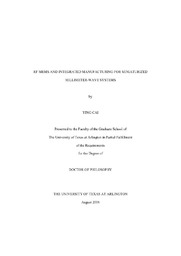
ATTENTION: The works hosted here are being migrated to a new repository that will consolidate resources, improve discoverability, and better show UTA's research impact on the global community. We will update authors as the migration progresses. Please see MavMatrix for more information.
Show simple item record
| dc.contributor.author | Cai, Ying | en_US |
| dc.date.accessioned | 2007-08-23T01:56:31Z | |
| dc.date.available | 2007-08-23T01:56:31Z | |
| dc.date.issued | 2007-08-23T01:56:31Z | |
| dc.date.submitted | August 2006 | en_US |
| dc.identifier.other | DISS-1396 | en_US |
| dc.identifier.uri | http://hdl.handle.net/10106/347 | |
| dc.description.abstract | Recently millimeter-wave systems have attracted more attentions in applications owing to their short wavelengths, high resolutions, broad bandwidths and high environmental tolerance. However, the great challenges of high fabrication and assembly costs, bulky volume, and heavy weight of millimeter-wave systems call for new integrated manufacturing techniques and novel architectures. The micro hot embossing technique integrated with other microfabrication techniques could address these challenges. In this dissertation, the micro plastic hot embossing technique was presented for the fabrication of miniaturized millimeter-wave systems. The micro hot embossing on plastic materials demonstrated its advantages on significant costs, volume, and weight reduction, while maintaining high performances.
A W-band rectangular waveguide and a W-band iris waveguide filter with integrated plastic flanges using micro hot embossing and selective electroplating have been designed, fabricated and characterized. A horn antenna with a waveguide feed has been fabricated and tested. These prototype devices show a promise for applications in millimeter-wave systems.
RF MEMS devices utilized in millimeter-wave systems can greatly improve system performance. A new multi-step actuator structure for RF MEMS was proposed in this work. Wider capacitance tuning range and higher capacitor ratio were achieved in this structure. With multiple actuation electrodes on steps, discrete levels of capacitances with tunable analog ranges, instead of binary states in the conventional structures, have been achieved. Multi-step structure design, fabrication issues and results have been investigated. The multi-step actuators were further utilized to design distributed MEMS transmission line phase shifters. Multi-level discrete varactors shorten the length of transmission lines and thus reduce insertion losses, while achieving more phase shifts.
Finally, direct and hybrid means are implemented to integrate RF MEMS devices with micro plastic hot embossed components. A three-physical-layer architecture is presented in this work to integrate antenna parts, transmission lines, RF MEMS devices, active components, and other off-chip devices in a millimeter-wave system. BCB (Benzocyclobutene) as a substrate and structure material, and the transition from a CPW (coplanar waveguide) to a waveguide play key roles in the 3-physical-layer structure for integration. | en_US |
| dc.description.sponsorship | Chiao, Jung-Chih | en_US |
| dc.language.iso | EN | en_US |
| dc.publisher | Electrical Engineering | en_US |
| dc.title | RF MEMS And Integrated Manufacturing For Miniaturized Millimeter-wave Systems | en_US |
| dc.type | Ph.D. | en_US |
| dc.contributor.committeeChair | Chiao, Jung-Chih | en_US |
| dc.degree.department | Electrical Engineering | en_US |
| dc.degree.discipline | Electrical Engineering | en_US |
| dc.degree.grantor | University of Texas at Arlington | en_US |
| dc.degree.level | doctoral | en_US |
| dc.degree.name | Ph.D. | en_US |
| dc.identifier.externalLink | https://www.uta.edu/ra/real/editprofile.php?onlyview=1&pid=232 | |
| dc.identifier.externalLinkDescription | Link to Research Profiles | |
Files in this item
- Name:
- umi-uta-1396.pdf
- Size:
- 2.077Mb
- Format:
- PDF
This item appears in the following Collection(s)
Show simple item record


